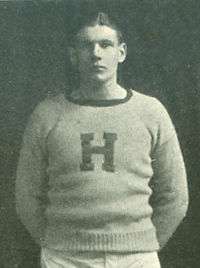Ralph Hills
|
Hills in 1921 | ||||||||||
| Personal information | ||||||||||
|---|---|---|---|---|---|---|---|---|---|---|
| Born |
January 19, 1902 Washington, D.C., U.S. | |||||||||
| Died |
September 20, 1977 (aged 75) Baltimore, Maryland, U.S. | |||||||||
| Height | 185 cm (6 ft 1 in) | |||||||||
| Weight | 95 kg (209 lb) | |||||||||
| Sport | ||||||||||
| Sport | Athletics | |||||||||
| Event(s) | Shot put, hammer throw | |||||||||
| Club | Princeton Tigers | |||||||||
| Achievements and titles | ||||||||||
| Personal best(s) |
SP – 15.26 m (1925) HT – 48.43 m (1924)[1] | |||||||||
Medal record
| ||||||||||
Ralph Gorman Hills (January 19, 1902 – September 20, 1977) was an American shot putter. After winning a bronze medal at the 1924 Summer Olympics, he married a state governor's daughter, graduated from Princeton and Johns Hopkins Universities, and became a physician. Hills lived near Baltimore, Maryland, and served in the United States Army during World War II.
Early life, education, and career
Hills, a grandson of U.S. Senator Arthur Pue Gorman, was born to Ralph Warren Hills (1875–1940),[2] a lawyer and diplomat, and Mary Edna Gorman Hills (1876–1944) on January 19, 1902. He attended The Hill School in Pottstown, Pennsylvania, from 1916 through graduation in 1921, where he was on the football team, served as class president, and developed his track athletics skills. Continuing his education at Princeton University, from which he graduated in 1925, Hills was captain of the track team. He pursued his M.D. degree at Johns Hopkins University, married Mary Joe Dixon (daughter of Montana governor Joseph M. Dixon) in 1928, and graduated in 1929. After an internship year at Union Memorial Hospital, and residencies at the Johns Hopkins Hospital, Hills entered private practice. During World War II, Hills served overseas with the U.S. Army's 18th General Hospital, and had the rank of Second Lieutenant when discharged.[3]
Athletics
Hills first joined an Olympic team at the 1920 Summer Olympics in Antwerp, Belgium.[4] He won a succession of AAU and IC4A collegiate titles, both indoor and outdoor, each year he was at Princeton. In 1924, Hills represented the United States at the 1924 Summer Olympics in Paris, France, and won the bronze medal for the shot put competition.[5]
Death and legacy
Hills taught students, staff, and nurses throughout his career, at Johns Hopkins and Union Memorial Hospitals.[3][5]
He died on September 20, 1977, from complications following a ruptured abdominal aneurysm.[3] Hill's alma mater, The Hill School, inducted him to their Athletics Hall of Fame in 2012.[4]
His first son, J. Dixon Hills,[6] graduated from Princeton in 1954 and entered the medical profession like his father as a physician.[3][7] His second son, Ralph Warren Hills (1939–2012),[8] also attended Princeton and was a WBAL television producer in Baltimore.[6][7][9]
See also
References
- ↑ Ralph Hills. trackfield.brinkster.net
- ↑ Hills, Ralph Warren (1922). Lex talionis; an analysis of the forces whose resultant produced the Treaty of Versailles. Baltimore, Maryland: Fleet-McGinley. Retrieved September 7, 2013.
- 1 2 3 4 Howard, John Eager, M.D. "Memorial: Ralph Gorman Hills" (PDF). Transactions of the American Clinical and Climatological Association. National Institutes of Health United States National Library of Medicine. Retrieved August 31, 2013.
- 1 2 "The Hill School Athletics Hall of Fame Class of 2012". The Hill School Alumni Association. 2012. Retrieved September 7, 2012.
- 1 2 "Ralph Hills Bio, Stats, and Results". Sports Reference. Retrieved August 31, 2013.
- 1 2 Sentementes, Gus G. (June 17, 2012). "Obituary for Ralph Warren Hills, long-time television producer for WBAL-TV". Baltimore Sun. Retrieved August 31, 2013.
- 1 2 "Ralph Warren Hills '61". Princeton Alumni Weekly. 113 (7). February 6, 2013. Retrieved August 31, 2013.
- ↑ "Ralph Warren "Hillsy" Hills". Hyde Bay Camp website. John Mercer. Retrieved September 8, 2013.
- ↑ "News Archive – 2012". Princeton University Class of 1961. Retrieved August 31, 2013.
External links
- Boone, Fletcher (2010). "Hopkins Goes to War: The Saga of the 18th Hospital" (PDF). Proto. I.

